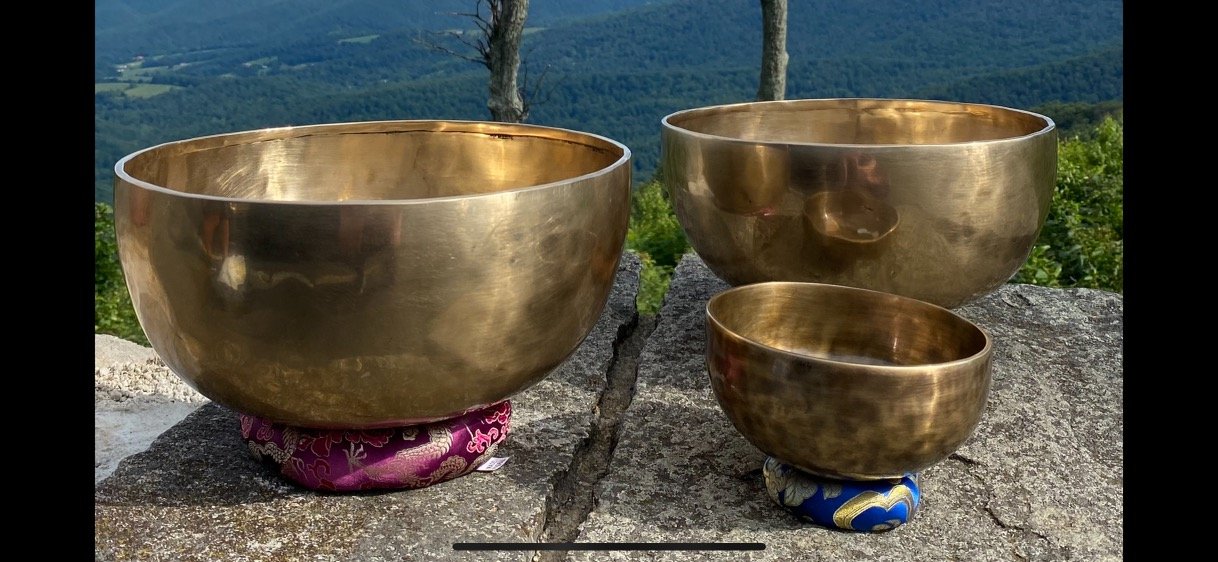About
Tibetan monks believe the Moon has energetic healing powers, so these bowls are only produced when a full moon is visible in the sky. They are infused with 7 metal alloys and hand-hammered over 1200 times by 2 people, just to create one bowl. Each bowl is a type of bell, which has a specific pitch, and a powerful sound with a vibration that lasts several minutes, and which can be heard and FELT when in close proximity to the body. This helps to induce relaxation throughout the body and nervous system.
Come experience this powerful healing modality, delivered by a world-class musician who uses her musical expertise to hear where your energy is stuck in the body, and then works to release it and promote vibrational healing.

History
Although many countries have claimed they are responsible for the first Singing bowls, it seems to have originated in the Himalayan areas of Nepal and India, and then spread out across the world, until they were used in China, Japan, Egypt, Tibet, and America. Nepal is considered the birthplace of Buddha, and there is proof the bowls existed there more than 5000 years ago, with some 2000 year old bowls still in existence.
They were first created out of necessity. They were used as a measure of grain, when one family would grow one crop and another would grow something else, and they would use the bowls to measure out an exchange of crops. According to Master Gopali, my singing bowl master, the bowls were also used as a form of medicinal healing when little else was available. For example, if a woman gave birth and lost a lot of blood, she would then drink out of the bowls, and would quickly regain lost minerals.
Each bowl consists of 7 earth metals, each representing a different Chakra, or energy point in the body, as well as the 7 plants or celestial bodies that were known to exist at this point in time. Copper, tin, zinc, iron, lead, gold, and silver are combined in an alchemical smelting pot and then hand hammered into bowls by 2 monks on the night of a full moon. A flat sheet of metal is hammered over a bowl form until it takes the shape of a bowl. The edges are then pounded until smooth, which is what gives the bowls their unique look and sound.
Although it began as a household item, over time many Indigenous cultures and ancient traditions worldwide began to recognize the power of sound to heal and transform consciousness. Monks in the Tibetan area started to use bells, tingsha, chimes and chanting to deepen their meditation. Native American Indians and Australian Aboriginals used repetitive sounds, and instruments made from nature in sacred ceremony, to help heal spiritual or physical imbalances. In India, the Hindu religion believes the universe was created by sound, and they use a lot of bowls and bells as well as chants like “OM” to open up the body. Many African cultures use drumming and chanting to lift them closer to Spirit. Today, across the globe, sound and music are an integral part of worship in nearly every religion.
My Tibetan bowls have an enchanting, mysterious, resonant, healing sound to them and are played by hitting, tapping, or rubbing them with a wooden mallet or striker (a form of wooden stick with a rubber end covered in felt). As Mitchell Gaynor, MD says in his book The Healing Power of Sound, “there is no organ or system in the body that’s not affected by sound and music and vibration.” I am acutely aware, as a professional singer, that everything in the universe is made of energy and has its own vibration. Your body is in a healthy state when each cell and organ resonates in harmony with your whole being. When part of your body is vibrating out of tune, we call it “dis-ease.”
Metal: Planet: Part of Body:
Gold Sun Heart
Silver Moon Root of the body
Copper Venus Sacral energy
Iron Mars Solar plexus
Tin Jupiter Crown of the head
Zinc Mercury Throat
Lead Saturn Third Eye
